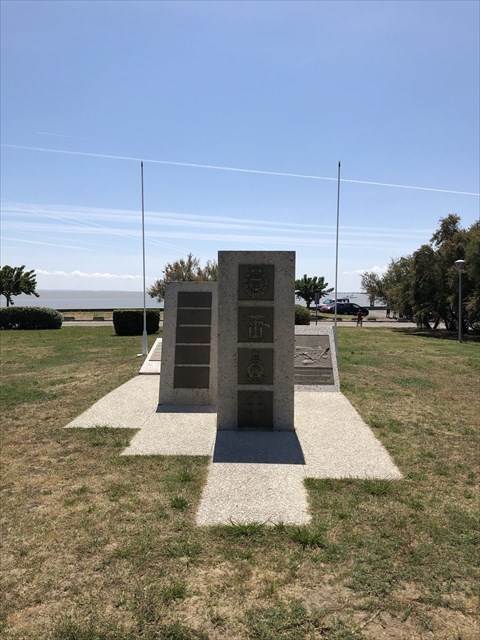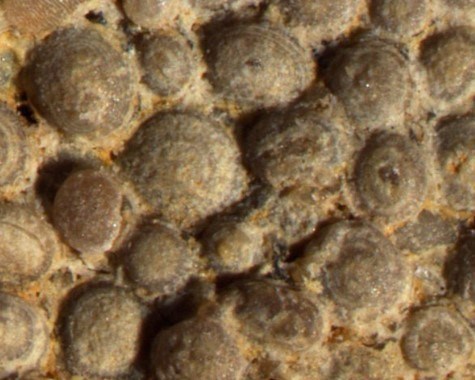La pierre de Portland est un calcaire du Jurassique. Il vient de Grande-Bretagne, plus précisément de l'île de Portland. Elle y est exploitée dans trois carrières. La carrière de Roach présente ici un intérêt particulier. La roche y est plus grossière et contient de nombreux fossiles. En outre, la pierre est très populaire, de sorte qu'elle est souvent utilisée dans de nombreux bâtiments et pierres tombales pour les soldats britanniques. Il a également été exporté dans de nombreux pays.
Aux coordonnées ci-dessus, vous pouvez voir un monument en pierre de Portland. Regardons de plus près celui-ci (géologiquement). Au monument on peut reconnaître encore bien des fossiles.

Les fossiles sont des restes "pétrifiés" ou des traces de plantes et d'animaux d'époques géologiques lointaines. Elles peuvent survenir lorsque, dans certaines circonstances, il n'y a pas de décomposition d'un être vivant mort, mais que les composants, la forme et la structure sont préservés. Ces circonstances comprennent le manque d'oxygène, qui empêche la décomposition, et le confinement étanche à l'air par des sédiments comme le sable. Par conséquent, les minéraux des sédiments peuvent pénétrer dans les minuscules pores et trous du squelette et le durcir sous la pression des couches superposées jusqu'à ce qu'il devienne "pétrifié".
On peut déjà voir à l'œil nu que cette pierre est très riche en fossiles, qui sont souvent composés de près de 50% de restes fossilisés avec une taille moyenne d'environ 350 mm. La pierre est connue pour sa grande résistance au gel et aux effets chimiques de l'eau de mer. Il s'agit d'un calcaire oolithique ouvert et structuré de la formation portlandienne, qui s'est formé au cours de la période tithonienne (il y a un million d'années, à la fin du Jurassique). Il est formé d'oolithes dans une matrice micrite (carbonate de calcium à grains fins). Il y a aussi des cavités dans la pierre causées par l'infiltration d'eau de pluie, qui dissout certains fossiles de coquillages, en tout ou en partie.

La pierre du monument se compose d'oolithes formées de sable, dans lesquelles il y a des coquillages et des parties dures de millions d'êtres vivants. Les coquilles et les vis Portland sont courantes dans la roche. Les coquillages sont des coquillages dans lesquels deux coquilles sont reliées par une charnière. On trouve souvent des huîtres et des fragments d'huîtres dans cette roche, et vous trouverez probablement des empreintes de coquilles de tailles et de formes différentes.
Les oolithes mentionnées ci-dessus sont des roches sédimentaires. Ils sont d'origine marine. Ils sont cimentés avec de petites briques minérales (oïdes). Les principaux composants des ooïdes sont principalement la chaux, l'hydroxyde de fer ou l'acide silicique. La granulométrie est de 0,5 à 2 mm. Ils sont donc à grain fin.
Les oolithes peuvent se développer dans l'eau, qui est chaude et très riche en calcaire. Une autre condition est que l'eau reste fortement en mouvement (vagues). Une autre condition préalable à la formation d'une oolite serait la formation d'un noyau de cristallisation (p. ex. un grain de sable). Progressivement, de plus en plus de particules se déposent les unes sur les autres. Lorsque l'eau de mer ne peut plus les transporter, elles se déposent sur les fonds marins. D'autres couches de sédimentation recouvraient les particules (grains de sable, fragments de coquille). Avec le temps, les oolithes se solidifient. Le calcaire ou l'argile cimente le tout. Le nom géologique de la solidification des sédiments est appelé diagenèse.

Heureusement, le degré de cimentation de la Pierre de Portland est suffisant pour résister aux effets néfastes des intempéries, mais il n'est pas si bien cimenté qu'il ne peut être facilement usiné (coupé et sculpté) par les maçons. C'est l'une des raisons pour lesquelles la Pierre de Portland est si populaire comme pierre monumentale et architecturale.
Traduit avec DeepL / Sources : www.wikipedia.de / www.albionstone.com / photo propre
Loguez cette cache "Found it" et envoyez-moi vos propositions de réponses soit via mon profil, soit via la messagerie geocaching.com (Message Center), et je vous contacterai en cas de problème.
1. Veuillez décrire la pierre en termes de couleur et de structure.
2. Si vous êtes assez près, pouvez-vous encore voir les restes du noyau cristallin dans les oolithes (pierre entre les fossiles) ? Une loupe peut être utile ici.
3 Quels fossiles pouvez-vous reconnaître ?
4. GRATUIT – Je serais heureux de recevoir une photo de vous ou de votre appareil GPS au monument. Mais s'il vous plaît, ne prenez pas de gros plans qui montreraient les réponses.

Portland stone is a limestone from the Jurassic age. It comes from Great Britain, more precisely from the Isle of Portland. There it is mined in three quarries. The Roach quarry is of particular interest here. The rock there is coarser material and contains many fossils. In addition, the stone is very popular, so it is often used in many buildings and tombstones for British soldiers. It has also been exported to many countries.
At the above coordinates you can see a monument made of Portland stone. Let's take a closer look at this one (geologically). At the monument one can recognize still well fossils.
By fossils one understands "petrified" remains or traces of plants and animals of long past earth ages. They can develop when under certain circumstances no decay of a dead living being takes place, but components, form and structure are preserved. These circumstances include the lack of oxygen, which prevents decomposition, and the airtight confinement by sediments such as sand. As a result, minerals from the sediments can penetrate into the tiny pores and holes of the skeleton and harden it under the pressure of the overlying layers until it becomes "petrified".
One can already see with the naked eye that this stone is very rich in fossils, which often consist of almost 50% fossilized remains with an average size of about 350 mm. The stone is known for its high frost resistance and resistance to the chemical effects of seawater. The stone is an open, structured oolithic limestone from the Portlandian formation, which was formed during the Tithonian period (a million years ago from the Late Jurassic period). It is formed from oolites in a micrite (fine-grained calcium carbonate) matrix. There are also some cavities in the stone caused by the seepage of rainwater, which dissolves some shell fossils, in whole or in part.
The stone at the monument consists of oolites formed of sand, in which there are shells and hard parts of millions of living beings. Shells and Portland screws are common in the rock. Shells are shellfish in which two shells are connected by a hinge. Oysters and oyster fragments are often found in this rock, and you will probably find imprints of many differently sized and shaped shells.
The above mentioned oolites are sedimentary rocks. They have a marine origin. They are cemented with small mineral bricks (oids). The main components of the ooids are mostly lime, iron hydroxide or silicic acid. The grain size is 0.5 to 2 mm. They are therefore fine-grained.
Ooliths can develop in water, which is warm and very rich in lime. A further condition is that the water remains strongly in motion (waves). The additional prerequisite that an oolite is formed would be a crystallization nucleus (e.g. sand grain). Gradually, more and more particles are deposited on top of each other. When the sea water can no longer carry them, they are deposited on the seabed. Further sedimentation layers covered the particles (grains of sand, shell fragments). In the further course of time, the ooliths solidify. The limestone or clay cements the whole. The geological name for the solidification of sediments is called diagenesis.
Fortunately, the degree of cementation in Portland Stone is sufficient to withstand the damaging effects of the weather, but it is not so well cemented that it cannot easily be machined (cut and carved) by masons. This is one of the reasons why Portland Stone is so popular as a monumental and architectural stone.
Translated with DeepL / Sources: www.wikipedia.de / www.albionstone.com / photo own
To log this EarthCache, please answer the following questions by email. You don't have to wait for a log release, I'll get back to you if something is wrong.
1. Please describe the stone in terms of colour and structure.
2. If you are close enough, can you still see the remains of the crystal nucleus in the oolites (stone between the fossils)? A magnifying glass can be helpful here.
3 Which fossils can you recognize?
4. Optional - I would be happy about a photo of you or your GPS device at the monument. But please don't take any close-ups that would show the answers.

Portland-Stein ist ein Kalkstein aus dem Jura Zeitalter. Er stammt aus Großbritannien, genauer gesagt von der Isle of Portland. Dort wird er in drei Steinbrüchen abgebaut. Interessant ist hier vorzugsweise der Steinbruch Roach. Das dortige Gestein ist gröberes Material und enthält viele Fossilien. Darüber hinaus ist der Stein sehr beliebt, deshalb wird er häufig bei vielen Gebäuden und Grabsteinen für britische Soldaten benutzt. Er wurde auch in viele Länder exportiert.
An den oben genannten Koordinaten siehst du ein Denkmal aus Portland-Stein. Sehen wir uns dieses nun mal genauer (geologisch) an. An dem Denkmal kann man noch gut Fossilien erkennen.
Unter Fossilien versteht man „versteinerte“ Überreste oder Spuren von Pflanzen und Tieren längst vergangener Erdzeitalter. Sie können dann entstehen, wenn unter bestimmten Umständen keine Verwesung eines toten Lebewesens stattfindet, sondern Bestandteile, Form und Struktur erhalten bleiben. Zu diesen Umständen gehören das Fehlen von Sauerstoff, wodurch eine Zersetzung verhindert wird, sowie das luftdichte Einschließen durch Sedimente, wie z.B. durch Sand. In Folge dessen können Mineralstoffe aus den Sedimenten in die winzigen Poren und Löcher des Skeletts eindringen und es unter dem Druck der aufliegenden Schichten bis zur „Versteinerung“ immer weiter verhärten.
Man erkennt schon mit bloßem Auge, dass dieser Stein sehr reich an Fossilien ist, die oft aus fast 50% versteinerten Überresten mit einer durchschnittlichen Größe von etwa 350 mm bestehen. Der Stein ist bekannt für seine hohe Frostbeständigkeit und die Widerstandsfähigkeit gegen die chemische Einwirkung von Meerwasser. Der Stein ist ein offener, strukturierter oolithischer Kalkstein aus der portlandianischen Formation, die sich während der tithonischen Zeit gebildet hat (vor einer Million Jahren aus der Spätjurazeit). Es wird aus Oolithen in einer Mikrit-(feinkörnigen Kalziumkarbonat-)Matrix gebildet. Es gibt auch einige Hohlräume im Stein, die durch das Versickern von Regenwasser verursacht wurden, das einige Muschel-Fossilien, ganz oder teilweise auflöst.
Der Stein am Denkmal besteht aus Oolithen, die sich aus Sand bilden und in denen sich die Muscheln und harten Teile von Millionen von Lebewesen befinden. Muscheln und Portland-Schrauben sind im Gestein häufig. Muscheln sind Muscheltiere, bei denen zwei Muscheln durch ein Scharnier verbunden sind. In diesem Gestein sind häufig Austern und Austernfragmente zu finden, und du wirst wahrscheinlich Abdrücke von vielen unterschiedlich großen und geformten Muscheln finden.
Die oben erwähnten Oolithen sind ein Sedimentgestein. Sie haben eine marine Herkunft. Sie sind mit kleinen Mineralbröckchen (Oide) verkittet. Hauptkomponenten der Ooiden sind meist Kalk, Eisenhydroxid oder Kieselsäure. Die Korngröße beträgt 0,5 bis 2 mm. Sie sind also feinkörnig.
In Wasser, welches warm und sehr reich an Kalk ist, können sich Oolithe entwickeln. Eine weitere Voraussetzung ist, dass das Wasser stark in Bewegung bleibt (Wellen). Die zusätzliche Voraussetzung, dass sich ein Oolith bildet, wäre ein Kristallisationskeim (z.B. Sandkorn). Nach und nach legen sich immer mehr Partikel übereinander. Wenn dann das Meerwasser diese nicht mehr tragen kann, werden sie auf dem Meeresboden abgelagert. Weitere Sedimentationsschichten überlagen die Partikel (Sandkörner, Muschelfragmente). Im weiteren Zeitverlauf werden die Oolithe verfestigt. Der Kalkt oder Ton verkittet das ganze. Der geologische Name für die Verfestigung von Sedimenten nennt man Diagenese.
Glücklicherweise ist der Grad der Zementierung in Portland Stone ausreichend, um den schädlichen Witterungseinflüssen zu widerstehen, aber er ist nicht so gut zementiert, dass er nicht ohne weiteres von Maurern bearbeitet (geschnitten und geschnitzt) werden kann. Dies ist einer der Gründe, warum Portland Stone als monumentaler und architektonischer Stein so beliebt ist.
Übersetzt mit DeepL / Quellen: www.wikipedia.de / www.albionstone.com / Foto eigen
Um diesen EarthCache zu loggen, beantworte bitte die folgenden Fragen per E-Mail. Auf eine Logfreigabe brauchst du nicht zu warten, ich melde mich, wenn etwas nicht stimmt.
- Bitte beschreibe das Gestein hinsichtlich Farbe und Struktur.
- Wenn du nah genug dran bist, kannst du bei den Oolithen (Stein zwischen den Fossilien) noch Rückstände des Kristallisationskeim erkennen? Eine Lupe kann hier hilfreich sein.
- Welche Fossilien kannst du erkennen?
- Optional - Über ein Foto von euch oder von eurem GPS-Gerät an dem Denkmal würde ich mich freuen. Aber bitte keine Nahaufnahmen, die die Antworten aufzeigen würden.